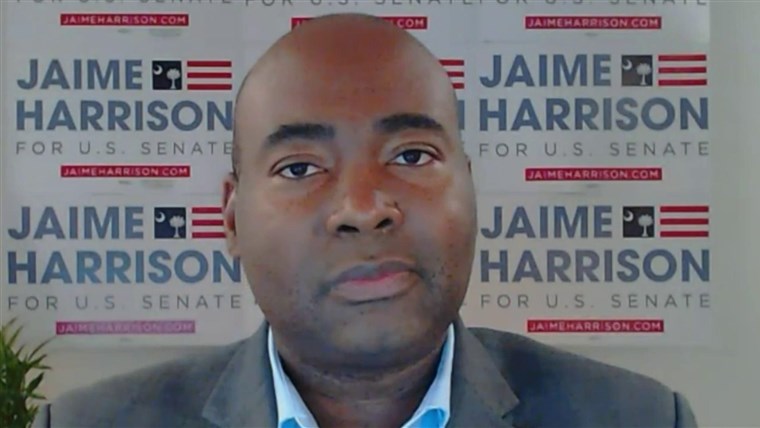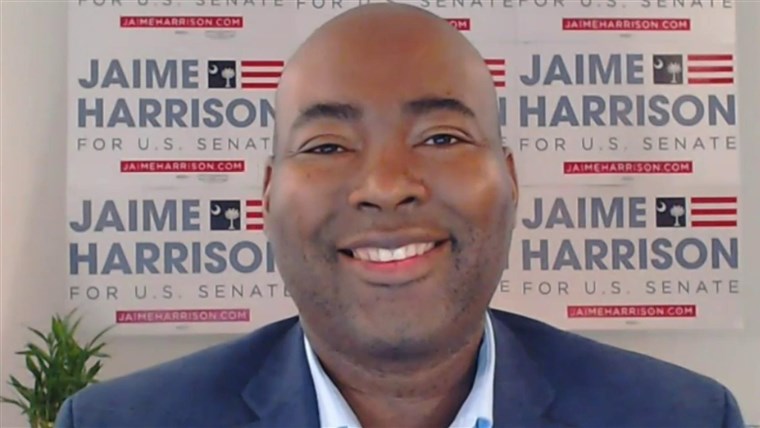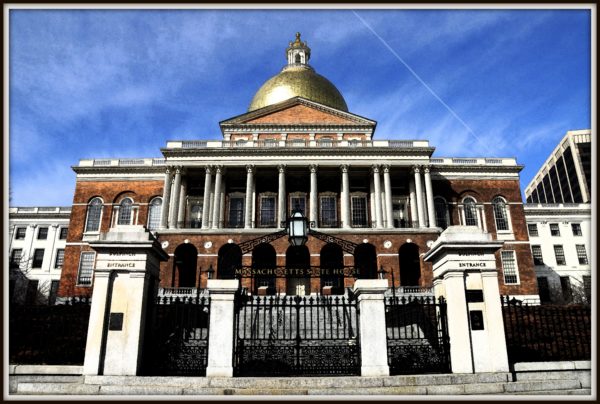GOOSE CREEK, S.C. — Kenyatta Grimmage likes to talk politics with his customers during the 20 or so minutes it takes to give each of them a haircut at Howard’s Barber Shop, which is Black-owned and also a school for apprentice barbers that takes up two small ranch homes along a busy roadway near the Charleston Naval Weapons Station.
In recent years, the conversations have been pessimistic about the state of politics in Washington, but Grimmage, 39, said there’s been a noticeable shift in tone in recent weeks. It’s something he’s never seen before — an excitement to vote, particularly in the tight race for South Carolina’s U.S. Senate seat between the Republican incumbent, Lindsey Graham, and his Democratic challenger, Jaime Harrison.
“It felt like a lost cause for so long,” Grimmage said, adding that many of his middle-age and older clients have registered to vote for the first time. “It felt like it didn’t matter if you voted or not — Lindsey Graham, Republicans, were going to be elected. But people are more energized now to push back against the negativity we’re seeing. Jaime Harrison represents that push back.”
The Harrison-Graham race has gained national attention for the tight polling numbers between a well-known GOP stalwart seeking his fourth term who has aligned himself closely with President Donald Trump, after losing the party’s presidential nomination to him in 2016 and denigrating Trump as the party’s standard bearer, and an insurgent Democrat whose message of resetting the political conversation has helped him raise an eye-popping $57 million in the final weeks of the race.
Harrison, 44, who is Black and a former state party chair, congressional aide and lawyer, was initially considered a long shot — South Carolina hasn’t elected a Democrat to the Senate in 22 years. But he quickly has turned the state, which voted for Trump by more than 14 points in 2016 and re-elected Graham, who is 65, by a slightly bigger margin in 2014, into a question mark in 2020.
Harrison has done that by reinvigorating a Democratic state party that, like many in the South, had not received much attention or investment from the national party in recent decades. He has helped expand voter outreach and taken advantage of party operatives who organized in the state during a contentious presidential primary, one that helped secure the presidential nomination for Joe Biden. (Republicans canceled their state primary.)
Many Black voters in the state have said that Harrison is a candidate who looks like them and rose above a working-class upbringing in rural Orangeburg to become the first member of his family to graduate from college and attend law school.
“So much of his story is our story, the African American community’s story,” said JA Moore, a Black lawmaker and rising Democratic figure in South Carolina who flipped a state legislative seat at the edge of Charleston in 2018. “Most of us are first-generation college graduates, most of us have family members we take care of once we ‘made it,’ most of us are paying back our student loans 15 to 20 years later. Jaime’s story is so relatable, and he can actually win — that’s what I think is motivating and inspiring folks.”
Nonwhite voters make up more than 30 percent of voter registration in the state this election, according to the South Carolina Voter Election Commission. That’s an uptick from 28 percent in 2016, which Democratic strategists in South Carolina argue could be the difference next month.
Another indication of Democrats’ excitement in South Carolina is that blockbuster fundraising haul that Harrison pulled in during the third quarter: The $57 million shattered the previous single-quarter fundraising record of any Senate race in American history.
“He actually has the money now to pay somebody to personally find every possible voter and deliver them to the polls,” Laurin Manning Gandy, a Democratic operative in the state who helped run Sen. Cory Booker’s presidential campaign in South Carolina, said with a laugh.
Jokes have been made about whether a candidate could spend that much money in the final weeks of an election cycle, especially in as small a market as South Carolina, but Harrison said he aims to.
Early investment has already bumped his name identification to rise to nearly 90 percent in recent days from less than 20 percent in February. And while much of traditional advertising has now been bought up, Harrison said his campaign plans to continue to flood the zone via every possible vehicle available to him between now and Election Day.
Voters said they continuously see his ads on everything from YouTube and Instagram to banner ads at the bottom of a free calculator app. His message is also seeping into the media markets in neighboring states, in Augusta, Georgia, and Charlotte, North Carolina.
“As soon as we get $1, we spend it and we’re putting it right back into the field,” Harrison said. “We are making sure we get our message out to every aspect of the state at this point in time, because that’s really important, so you can’t turn on TV or open your email or anything or open social media without seeing my big brown face smiling at you.”
Harrison’s campaign did not give specifics how they plan to spend the funds, but the money — and what now constitutes one of the best donor lists in the country — puts Harrison in a position to be an influential figure in the Democratic Party beyond this election cycle. With a crop of Democratic candidates competing for Senate seats across the South, Harrison could help buoy them by sharing his money with the Democratic Senatorial Campaign Committee.
It’s quite likely, however, that Harrison will choose to help rebuild the state party that he once ran, something he has already started to do. Federal Election Commission data shows that Harrison’s campaign has funneled nearly $500,000 to the Democratic Party of South Carolina in increasing sums since the spring.
His funding and championing of Democrats in the state could have major implications in down-ballot races, including the state Senate, where Democrats are competitive in races that could lead them to take control for the first time since 2000. That could have quite a ripple effect as the state examines redistricting next year.
Tyler Jones, a Democratic strategist in South Carolina who helped Rep. Joe Cunningham flip a Republican-held congressional seat in the state for the first time since 1986, said Harrison is helping to elevate down-ballot races with his messaging and by increasing voter interest.
“If this wave continues to build and Republicans just get wiped out, I think there’s a decent chance Republicans lose quite a bit of control here,” Jones said. “We haven’t had the majority as long as I’ve been in politics, but there’s a real chance we take the state Senate.”
But Harrison, and Democrats in this state, will need a broad coalition — not just Black voters — to declare victory on Nov. 3.
Harrison, who cut his teeth working as political floor director for Rep. Jim Clyburn, D-S.C., when Clyburn was House majority whip, is well versed in counting votes. He knows how to make the math work to pass legislation or get a candidate elected.
To win in South Carolina, Harrison has adopted the model Graham has used to win elections here since the mid-’90s, though slightly flipped: enlist Democrats, sweep independents and turn out moderate Republicans.
“He had a sort of center-right coalition that he had pulled together,” Harrison said of Graham. “And what I’m trying to do is take my pragmatism, just wanting to make sure that we make progress, and make South Carolina a better place. And I think that’s attractive to a lot of folks, particularly folks who used to support Lindsey Graham.”
What Harrison is banking on is that this coalition has moved away from Graham, many taking issue with the senator’s tightknit relationship with Trump and Graham’s abuse of Democrats, who he called “nuts” during a debate earlier this month.
That’s a significant shift from races in 2008 and 2014 when Graham specifically courted Democrats, calling himself in election mailers “an independent voice” known for “reaching across party lines,” and encouraging voters to “look behind the mask of the ‘Democratic’ nominee for U.S. Senate” because the candidate did not support the party enough. Many voters said they’ve noticed Graham’s changing views.
“It seems like Lindsey Graham is up and down and supports whatever’s convenient,” said Ethel Amaker, 71, a native of Harrison’s hometown, Orangeburg. “Now he’s teamed up with the president for quite a long time and, to me, it just looks like he’s just trying to get attention and help himself.”
Mike Hemlepp, 55, said this will be the first election in which he’ll vote a straight party ticket. Since Graham first ran for the Senate in 2002, Hemlepp has voted for Graham — “because he was a moderate and a real Republican” — and a mix of Republicans and Democrats for other offices. This year, Hemlepp will vote for all Democrats.
“We were all proud of him, even if we didn’t agree with him on everything,” Hemlepp, who lives in Columbia, said of Graham. “He never embarrassed us. Then Donald Trump got elected and people can debate how and why, but Lindsey Graham changed. I don’t know what happened to him.”
Graham’s campaign did not respond to a request for comment.
Former South Carolina Gov. Mark Sanford, a Republican who ran a short-lived presidential campaign against Trump this election cycle, said that the leaders of his state party may have grown “complacent and comfortable” after holding power here for decades — which may explain Graham’s absence from the campaign trail until recently.
But Sanford said the biggest issue is that “there’s a half-life to caustic and rude,” especially in polite South Carolina society, and state Republicans have tied themselves too closely to Trump’s astringent rhetoric, putting off many voters here.
“I don’t know if Trump’s going to win or lose, but if he loses, there’s one guy who beat him: himself,” Sanford said. “And If he loses, he’s going to take a lot of people here in South Carolina down with him.”
Download the NBC News app for breaking news and politics
The momentum appears to be with Harrison, with polls now showing him neck-and-neck with Graham after being down by nearly 15 points earlier this year.
Harrison’s campaign appears to be capturing the ways that South Carolina and the South at large are changing rapidly. Republicans’ winning in the South aren’t a sure bet anymore, though they certainly will maintain a leg up in elections throughout the region.
“They’re a little rusty,” Harrison said of the Republican Party. “They didn’t anticipate actually running against quality candidates that have the resources to get their message out. And so I think all of these factors have allowed for the stars to align here in South Carolina, and I believe the winds of change in the New South are going to emerge right here in our state.”




